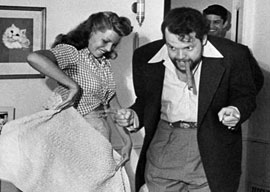
June 12, 2013

Rita Hayworth and Orson Welles
For obvious reasons, this was not what I said to camera that day in Ronda. They wanted far thinner conceptual gruel, so I gave them some well-worn”to me”stories, such as that of Welles and that other great aficionado, Ernest Hemingway, from first fistfight to firm friendship, and how, in Welles’s words:
…we never discussed bullfighting, because except on the subject of Ordoñez we disagreed profoundly on too many points. He thought he invented it, you know. He really did think he invented it. Maybe he did.
I also gave them Welles’s magisterial artistic/dramatic analysis of the corrida de toros as delivered to the travel writer James A. Michener in his book Iberia:
What it comes down to is simple. Either you respect the integrity of the drama the bullring provides or you don’t. If you do respect it, you demand only the catharsis which it is uniquely constructed to give….What you are interested in is the art whereby a man using no tricks reduces a raging bull to his dimensions, and this means that the relationship between the two must always be maintained and even highlighted. The only way this can be achieved is with art. And what is the essence of this art? That the man carry himself with grace and that he move the bull slowly and with a certain majesty. That is, he must allow the inherent quality of the bull to manifest itself.
What I didn’t do was take them any further down this natural evolution of this type of afición, the trajectory which Welles followed. I didn’t give them the line about how he saw himself as a torista not a torerista.
There are two kinds of people who follow the bulls, as they say in Spanish. There are those people who follow because they love the bullfighters, and there is a very small minority who are interested in the bulls, and I was always most interested in the bulls…my interest in bulls was like the interest of somebody who is very keen and very knowledgeable about horses. I know a great deal about bulls, and I’m much more interested in them, than in the men who fight them.
Nor did I mention Welles’s final destination on that path:
I’ve turned against it [bullfighting] for very much the same reason that my father, who was a great hunter, suddenly stopped hunting. He said, “I’ve killed enough animals and I’m ashamed of myself.”…I began to think that I’ve seen enough of those animals die.
So have I seen enough of those animals die? No, just as I have not eaten enough meat yet (both activities are as unnecessary and “entertainment”-based as each other; one for the soul, the other the palate.)
However, I have stopped pretending that I am bullfighter. And that there is any intrinsic dignity in being able to perceive how another man creates art from injury and elegance. Of course, I say that with my tickets booked for Pamplona where I will be running with the bulls this year for my fourth feria in de San FermÃn. And for the month after that for my second feria in the much older”the oldest in fact”but much less famous encierro (bull-run) in the Spanish town of Cuéllar. (I described my first feria there in a recent issue of the Financial Times.)
Welles knew you can never completely leave the bulls. This is why his ashes are interred at his request in the gardens of the house of Antonio Ordóñez in Ronda, now belonging to Cayetano and his former matador brother Francisco.
However, that world truly belongs to the toros and toreros themselves, which is why Ordóñez’s ashes lie under the sand of his plaza de toros in Ronda, in front of the toril gate, so that on entering the ring, the bulls could finally run over him in death as they never could in life.